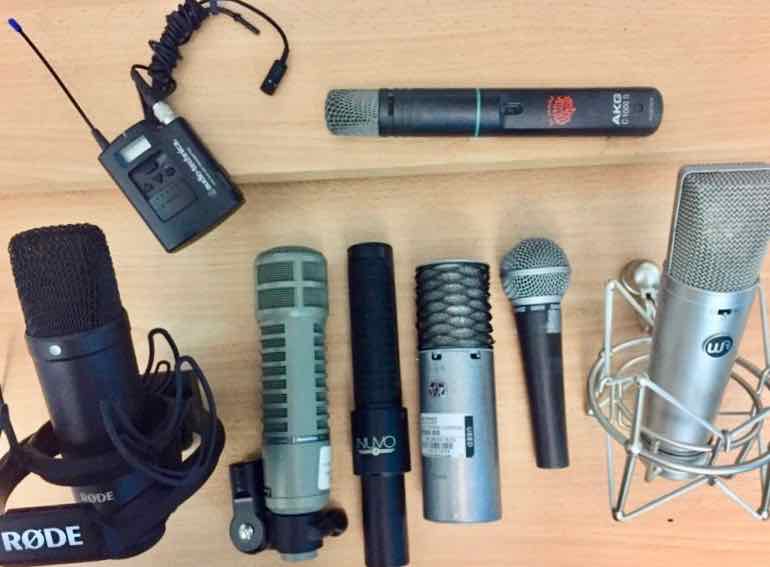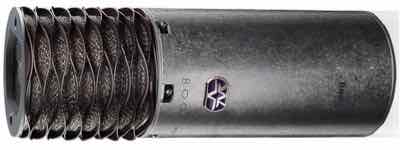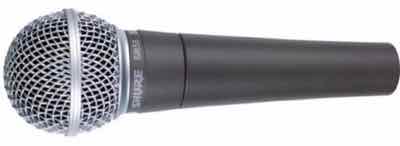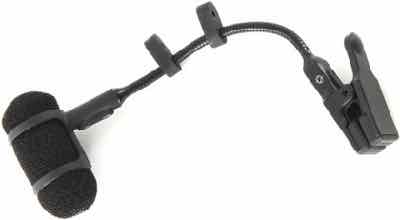
8 Saxophone Microphones Comparison
I tested 8 different saxophone microphones in my home recording studio. Price ranging from under $100 to around $1000. These mics are not exclusive to recording a saxophone of course but they fall into a category of a certain type of mic that works well for sax.
Keep in mind that the saxophonist will make a difference with the type of sound he or she produces. Saxophone tone ranges from soft, dark, to very loud and bright. A person who has a very bright tone might not want to go with the brightest sounding mic.
These are the mics used:
- AKG C1000S (under $200)
- Rode NT1 (under $300)
- AST Spirit (under $500)
- WA-87 (under $600)
- EV RE20 (under $500)
- AEA N8 Nuno (under $1000)
- Shure SM58 (under $100)
- ATW T310 (mic is under $100 but needs transmitter and receiver)
Saxophone Setup Used:
- Vintage 1960 Selmer Mark 6 Tenor Saxophone
- Dave Guardala Gold Plated Metal Mouthpiece (Michael Brecker model)
- Fiberreed Synthetic Reed (Onyx)
 Give a listen and share your thoughts in the comment section below.
Give a listen and share your thoughts in the comment section below.
– Johnny
1. AKG C1000S
 Listen to it
Listen to it
Made in Austria. The AKG C1000S is a small diaphragm condenser microphone. It has a cardioid pickup pattern which means it’s most sensitive on the front.
This is the mic I’ve been using in my home studio for the last several years. All the video uploads of songs on the Youtube channel www.youtube.com/saxjohnny up until now have been done using this AKG C1000S.
It’s a very good all-round mic for any recording studio because of it’s versatility. We’ve also used it on acoustic guitar, bass and vocals as well. I just happened upon it years ago not even thinking about how it would record the saxophone but thankfully its worked out very well.
2. Rode NT1
 Listen to it
Listen to it
Made in Australia. The Rode NT1 is a large diaphragm condenser microphone. A large diaphragm mic will have a 1 inch diaphragm or even larger. Large diaphragm mics can make an instrument or voice bigger and warmer than a small condenser mic. Both have their pros and cons…
A small condenser mic will pick up a more realistic and natural sound whereas a large diaphragm mic, although producing a bigger sound will color that sound, each model doing so in it’s own way.
3. AST Spirit
 Listen to it
Listen to it
Made in Great Britain. The AST Spirit is multi-pattern large diaphragm microphone. It has a switch on the front that can be changed from the cardioid pattern to a omni-directional pattern which picks up sound from the front, sides, and rear. The 3rd is a figure 8 pattern which picks up sound from the front and rear.
These different patterns have their uses but for saxophone the best is the cardioid pattern, picking up the sound from straight on.
I recently used the AST Spirit on a new saxophone song video here:
http://www.howtoplaysaxophone.org/walk-dont-run-saxophone-music-backing-track
4. WA-87
 Listen to it
Listen to it
Warm Audio is made in the United States of America. The Warm Audio WA-87 is their attempt at copying one of the most popular large diaphragm studio mics of all-time; the Neuman U-87.
The U-87 costs several thousand dollars but the WA-87 is under 600. Maybe one day I’ll have a comparison with the U-87 here but for now we’ll just compare with the other mics here now.
5. EV-RE20
 Listen to it
Listen to it
Made in the USA. The RE20 is an industry standard in broadcasting and recording studio alike. It’s a dynamic cardioid pattern mic used for voice and many instruments.
6. AEA-N8 Nuno
 Listen to it
Listen to it
Audio Engineering Associates (AEA) microphones are made in the USA. The N8 is a ribbon mic. This type of mic has been around for many decades. Uses an aluminum type ribbon which vibrates between two magnet poles to make the electrical sound.
They have a distinct sound and many studios still use them. They have a very smooth, natural, darker sound than these other mics here.
7. Shure SM58
 Listen to it
Listen to it
Made in the USA. The Shure SM58 is most likely the most used microphone of all. It’s very inexpensive and built to take a pounding. It was made for the live stage when bleeding from other instruments like loud drums and electric guitars would get picked up by other microphones. Not the 58 though.
This is a dynamic cardioid mic used mostly for live vocals. It’s pretty nice and natural on the sax as well and works best up close.
8. Audio Technica ATW-T310
 Listen to it
Listen to it
This has been my wireless mic setup for live stage performing over the last several years. It’s great for that purpose but not so much for the recording studio environment. It’s small size just can’t handle the frequency range needed for the saxophone.
Although I would never use it to record, I included it here because I know many people do use this type of mic to record at home because of price and convenience.
If you’re in Canada try Amazon.ca for occasional good deals on mics



Grande Johnny! !!! Ti faccio i complimenti dalla Sardegna!!!!! Super!
I have a Royer R-121 ribbon mike. I like it. I don’t know much about mics, only what is recommended by music artists like JF or music places like Sweetwater https://www.sweetwater.com/c403–Ribbon_Microphones
AE-N8 sounded the darkest and it is the sound I like best, the price reflects this I suppose.
The Rode would be my second choice followed by the Sure SM 58.
The ev-re20 sounds the closest to how ‘the Beatles’ sound, and some of their sound recordings were jaw dropping – i love how the sound flows as it plays back.
no 8 sounds like you’re playing in a box, most of the mics aren’t sounding very good on the higher notes including the darker and brighter sounding mikes.
I guess because I have somewhat of a low budget I would not mind trying # 8 because its wireless and inexpensive, or # 7, which looks like, according to your comments, that it works well closeto up, which is my office, for recording at home , even if I bought each of them its still not a lot of money out of pocket. I am no where near ready for a stage lol. Vinny
go with a shure 58 or 57 Vinny, you can get em for under 100 bucks, even less used. the shure 57’s (not shown in my comparison) are great sax mic.
I used one live for many years. they’re a little like the 58’s but a little crisper and that’s what I personally like on sax.
Hi Johnny,
I wanted to set up a mini home recording studio. Something small to start recording my sax playing.
I’m currently using an M-audio USB mic that plugs directly to a USB port on my Macbook Pro.
I am using Garage Band and Logic pro X as well. Which mic do you recommend I get and what other devices will I need to get to connect to my home computer? I do not want to spend too much money as well.
Thanks
you can record with what you already have.
you can also make some upgrades as you are ready and able….
I’m not sure about a USB mic and how they compare but a condenser or dynamic mic going into a pre amp first, then into an audio interface will give you a better sound than just a USB directly into your computer. That’s the type of set up I use.
Hi Johnny, this comparison test gives one a good idea about microphone performance.
I just wish my sax performance was as Shure as the SM58!
I started out using a Samson G Track USB direct into my Mac computer then Garage Band. The mic worked well as far as quality but it was a bit of a hassle connectivity wise. Keep in mind this was in 2014/15 so I’m thinking those types of mics have gotten a lot more user friendly. I now do what Johnny does. I route the mics to a Presonus Audio Box which has 8 inputs but you can get smaller less expensive ones with just one and two inputs. I’m not a salesman for Presonus but it was easy to figure out and also comes with Studio One software which is a higher end/more professional version of Garage Band. Truth is for what I do GB works just fine. I’m guessing if you looked at other preamps they probably package them with software as well should you want to upgrade to something better than GB. Mic wise I use the SM58 and 57. They work great and are real work horses. They’ve been dropped, had drinks spilled on them etc and they keep going.
Hi Johnny i’d like your comment about AMT TA6 and Quantum 7 wireless
never tried that mic but at least they are specifically made for saxophones so they should be ok as far as capturing the frequencies. what some guys do is use a clip-on vocal mic and that would not be as good.